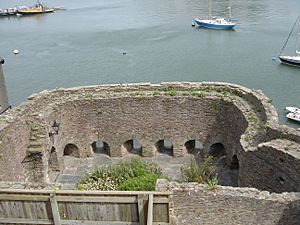Bayard's Cove Fort facts for kids
Quick facts for kids Bayard's Cove Fort |
|
|---|---|
| Dartmouth, Devon | |

The fort entrance, viewed from the quay
|
|
| Coordinates | 50°20′52″N 3°34′39″W / 50.34789°N 3.57749°W |
| Type | Artillery fort |
| Site information | |
| Owner | English Heritage |
| Open to the public |
Yes |
| Condition | Ruined |
| Site history | |
| Materials | Limestone |
| Events | English Civil War, Second World War |
Bayard's Cove Fort is an old English fort from the 1500s. It was built to protect the entrance to Dartmouth Harbour in Dartmouth, Devon. This fort, also called Berescove or Bearscore Castle, had eleven openings for large cannons. Its job was to stop enemy ships that got past the bigger Dartmouth Castle and Kingswear Castle.
The fort was used during the English Civil War. Later, in the 1700s, it was not used much and became a storage place. It was fixed up in the late 1800s. Today, English Heritage looks after the fort, and you can visit it.
Contents
History of Bayard's Cove Fort
Building a Coastal Defence (1500s)
Bayard's Cove Fort was built in the early 1500s. It helped protect the important trading and fishing town of Dartmouth in Devon. Dartmouth's harbour was a very busy place. It could hold up to 600 ships at one time. The town was doing well from selling wool.
People worried about France invading England. To help protect the town, Dartmouth Castle was made stronger after 1486. Another fort, Kingswear Castle, was built from 1491.
Historians are not sure exactly when Bayard's Cove Fort was started. It might have been around 1509–10, when Henry VIII was king. Or it could have been in 1529, when Dartmouth feared attacks from France and Spain. We know for sure the fort was finished by 1537.
The fort was placed at the end of a new quay (a dock for ships). It was near the harbour entrance. Its purpose was to fire at any enemy ships that got past Dartmouth and Kingswear castles. It probably looked like a round tower at first. In 1575, the town rented the fort to a shipbuilder. But the town could take it back if needed for defence. This happened in 1598 when Spain threatened to invade.
The Fort in the 1600s
In 1642, the English Civil War began. This was a fight between King Charles I and Parliament. Dartmouth first supported Parliament. In 1643, Prince Maurice attacked and took the town. The town's defences were weak from the land side.
In January 1646, Sir Thomas Fairfax led Parliament's army to take Dartmouth back. They captured Bayard's Cove Fort. The Royalists had placed five iron cannons there to protect the harbour.
After the war, a governor named Sir John Fowell was put in charge. He managed Dartmouth's defences and stopped smuggling. In 1650, the fort was ordered to be fixed and used fully again. When Charles II became king in 1660, he first let the town control the defences. But by 1662, a royal army of 23 men was stationed at Dartmouth. Sir John Fowell remained in charge until 1677.
Later Years (1700s–Today)
In the 1700s, the fort was used for storage. It slowly fell apart. But in the late 1800s, tourists started visiting Dartmouth. The fort was then fixed up. During the Second World War, it was briefly used as a machine-gun post.
Today, English Heritage manages Bayard's Cove Fort. It is open for visitors to explore. The fort is also protected as a Grade I listed building in the UK. This means it is a very important historical site.
What the Fort Looks Like
The fort is a stone building called a blockhouse. It was probably built in at least two stages. Its original round shape was changed later to be more uneven. The outside of the blockhouse is about 58 feet (18 m) by 70 feet (21 m). The inside is about 16 metres (52 ft) by 15.5 metres (51 ft). A wall made of limestone rubble surrounds an area cut into the cliff behind it. The outer eastern wall is now 6 feet (1.8 m) thick and 15 feet (4.6 m) high.
There are eleven gunports (openings for cannons) on the ground floor. These are close to sea level. They look similar to those at Dartmouth Castle. The fort would have had a wall-walk and a parapet (a low wall) to protect soldiers with muskets. One of the gunports has been changed into an entrance. Another has been blocked off. The original living area for the soldiers was on the west side. But this, and later changes for storage, are now gone.




